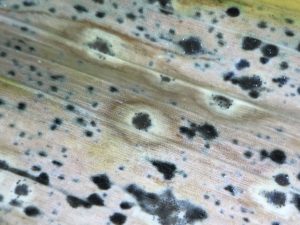Now that the field season is upon us, it is a good time to go over some tips and tricks for diagnosing field issues. One item that I always mention to CCA’s and others involved in field-level work is that identifying a disease in the field is not always straight forward. Think of how diseases work- some kill tissues and feed off the dead or decaying tissue, others “suck” nutrients from living tissues, others infect stems and roots, causing rots or wilts. Examples of these issues and how symptoms overlap in soybeans can be found in a past post.
Many abiotic disorders, such as herbicide damage, spray issues, nutrient issues, and compaction can cause symptoms on plants that resemble diseases and vice versa. Therefore, it is important that when issues are noticed in the field, that you do not simply focus on the symptoms observed on single plants. One must take in the whole picture and ask the right questions. Here are some tips for diagnosing issues in the field.
1) Examine the entire field to look for patterns. Diseases are not found in lines, strips, squares, etc. If you see these sorts of patterns in the field, you are likely dealing with something abiotic, such as a spray issue or similar
2) Gather pictures of the field from a distance and close up, and note the patterns. These images and information will be important if you want to send them to specialists for opinions. Do not simply take a picture of a single leaf, head, or root and ask, “What is this?” as your answer is likely to not come with a great deal of certainty.
3) Acquire as much information about the field history as possible. What variety or hybrid was planted? What nutrients and chemicals were applied and when?
4) Note recent weather patterns. How do these patterns relate to the putative disease or abiotic disorder?
5) Send images with information to local and regional specialists to gather their opinions. Have a disease issue? Feel free to contact me
6) If you suspect a disease, confirm it by sending to the plant diagnostic clinic. Give them all information including images of the field, history, variety, etc. This will help them make an informed diagnosis.
Remember, accurate diagnosis of issues will save you money in the long run. Take the time and be thorough, and you will be rewarded in the future.


